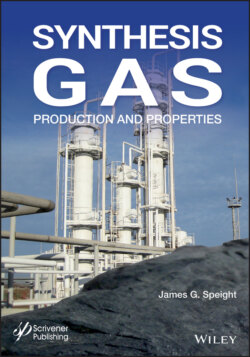Читать книгу Synthesis Gas - James Speight G., James G. Speight - Страница 43
2.5 Gasification Processes
ОглавлениеAll of the main types of gasifiers (Chapter 3) can be adapted to be used with various waste types as feedstock, but plasma gasification is becoming a technology of the near future, especially in regard to the treatment of municipal solid waste. In the plasma gasification process, the plasma (ionized gas at high temperature which conducts a strong electrical current) allows extremely high gasification temperatures of 4000oC (7200oF) to over 7000oC (12600oF). These high temperatures completely break down toxic compounds to their elemental constituents, making them easily neutralized, and the gas is mixed with oxygen and steam inside the gasifier. The organic compounds in the fuel are converted to synthesis gas, similar to the other gasification technologies, and any residual materials are captured in a rock-like mass which is highly resistant to leaching. With this technology, all known contaminants can be easily contained, making it ideal for municipal solid waste applications where feedstock composition is sometimes unclear. Also, after the initial electricity required at startup for the plasma gasifier, these systems are self-sustained by running off the electricity produced by firing the synthesis gas in a gas turbine.
Thus, gasification processes can accept a variety of feedstocks but the reactor must be selected on the basis of feedstock properties and the behavior of the feedstock in the process. Gasification processes are segregated according to bed types, which differ in their ability to accept (and use) caking coals and are generally divided into four categories based on reactor (bed) configuration: (i) fixed bed, (ii) fluidized bed, (iii) entrained bed, and (iv) molten salt.
In a fixed-bed process, the coal is supported by a grate and combustion gases (steam, air, oxygen, etc.) pass through the supported coal whereupon the hot produced gases exit from the top of the reactor. Heat is supplied internally or from an outside source, but caking coals cannot be used in an unmodified fixed-bed reactor.
The fluidized-bed system uses finely sized coal particles and the bed exhibits liquid-like characteristics when a gas flows upward through the bed. Gas flowing through the coal produces turbulent lifting and separation of particles and the result is an expanded bed having greater coal surface area to promote the chemical reaction, but such systems have a limited ability to handle caking coals.
An entrained-bed system uses finely sized coal particles blown into the gas steam prior to entry into the reactor and combustion occurs with the coal particles suspended in the gas phase; the entrained system is suitable for both caking and non-caking coals. The molten salt system employs a bath of molten salt to convert coal (Cover et al., 1973; Howard-Smith and Werner, 1976; Speight, 2013).
The aim of underground (or in situ) gasification of coal is the conversion into combustible gases by combustion of a coal seam in the presence of air, oxygen, or oxygen and steam. Thus, seams that were considered to be inaccessible, unworkable, or uneconomical to mine could be put to use. In addition, strip mining and the accompanying environmental impacts, the problems of spoil banks, acid mine drainage, and the problems associated with use of high-ash coal are minimized or even eliminated.
The principles of underground gasification are very similar to those involved in the above-ground gasification of coal. The concept involves the drilling and subsequent linking of two boreholes so that gas will pass between the two (King and Magee, 1979). Combustion is then initiated at the bottom of one bore-hole (injection well) and is maintained by the continuous injection of air. In the initial reaction zone (combustion zone), carbon dioxide is generated by the reaction of oxygen (air) with the coal:
The carbon dioxide reacts with coal (partially devolatilized) further along the seam (reduction zone) to produce carbon monoxide:
In addition, at the high temperatures that can frequently occur, moisture injected with oxygen or even moisture inherent in the seam may also react with the coal to produce carbon monoxide and hydrogen:
The gas product varies in character and composition but usually falls into the low-heat (low Btu) category ranging from 125 to 175 Btu/ft3 (King and Magee, 1979).
